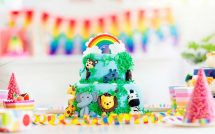
Help your child express their emotions using these art projects and coloring activities. It’s important for children to learn healthy ways to verbalize their emotions. But for very young children, it can be difficult to identify and express these big feelings. Toddlers don’t always have the words to describe their experiences. With these children’s crafts and activities, you can help your child recognize and understand their feelings. By helping your child process their emotions, you also support their social development and emotional intelligence. Try a few of these fun color activities to learn about emotions!
7 Art Projects and Children’s Activities to Learn about Emotions
Stoplight Craft Activity
Craft your own stoplight to understand emotions! Color a stoplight and cut it out. On a streetlight red means stop. For this activity, red is associated with extreme out-of-control emotions like anger, devastation, or love. Yellow is associated with slightly elevated feelings like silliness, anxiety or unease. We have slightly more control over these feelings, and our heart beats a little slower. Green is associated with easy-going emotions like happiness or contentment—emotions that slow our heart and make us feel calm. When your child wants to express their emotion but doesn’t have the words, use the stoplight and ask them to point to the corresponding stoplight color. This craft activity will help them articulate those emotions.
Coloring and Activity Books
Introduce your child to coloring and activity books that help them learn about their emotions. A personalized coloring book like Color My Feelings will engage the child in fun and educational activities such as drawing their own face, matching the emotion to the right facial expression and solving a feelings word search.
Emoji Emotion Puppets
Craft your own emoji puppets that your child can use to identify their emotions. To begin, draw emoji face outlines on white paper that include: happy, sad, angry, silly, and sick. Cut out the faces. Then color the faces—yellow like traditional emoji symbols or in different colors to match the emotion (yellow for happy, red for angry, orange for silly, blue for sad, and so on).
Emotion Chart
If your child is struggling with a big emotion, create a feelings chart. Make a chart that shows faces expressing different emotions with the emotion written underneath. Then present the chart to your child and ask them to color in the face they are feeling. They can also color in several faces if they are experiencing a few emotions all at once. By identifying these emotions, your child can more easily process them and work through strong emotions like anger or sadness.
Emotion Monster Dolls
Craft your own adorable monster dolls to identify emotions. Wrap empty toilet paper rolls in construction paper. Select colors that correspond to different emotions: blue for sadness, red for anger, yellow for excitement, purple for peaceful and so on. Then color your monsters with faces and features that match the emotion. Go a step further and glue on fun craft accessories like googly eyes, pom poms, feathers, and pipe cleaner antennae. When your child is having a big emotion but can’t express it, ask them to select their emotion doll. They can choose the doll that best represents their emotion and use the doll as an emotional support to play with. A recent study found that when children play with dolls, they are more likely to talk about others’ thoughts and emotions. This positively benefits a child’s social skills, ability to interact with others, and their overall emotional development. By selecting and playing with their monster dolls, your child will build their social and emotional skills.
Finger Paint My Feelings
Have your child finger paint a picture based on the question: How am I feeling today? For mess-free fun, add finger paint to a large plastic lunch bag so your child can draw lines in the paint using their finger on the outside. This is a great art project to do once a week or every day to help your child identify their emotions and feelings.
My Emotion Selfie
Using a paper plate and markers, your child will draw a selfie that represents their current emotional state. If they are happy, they can draw a smiling face and use colors that represent the emotion. Color a realistic face or an abstract one with symbols that represent the emotion. Turn your selfie into a colorful work of art!
Resources:
https://www.actionforhealthykids.org/activity/feeling-through-colors/





